How to Grow Microgreens at home! Here’s a simple, step-by-step guide on how to grow microgreens (like broccoli sprouts) indoors to add to Buddha Bowls, salads, sandwiches, or wraps. Not only are they packed full of nutrients, but they are also guaranteed to bring a little joy. Includes a Video.
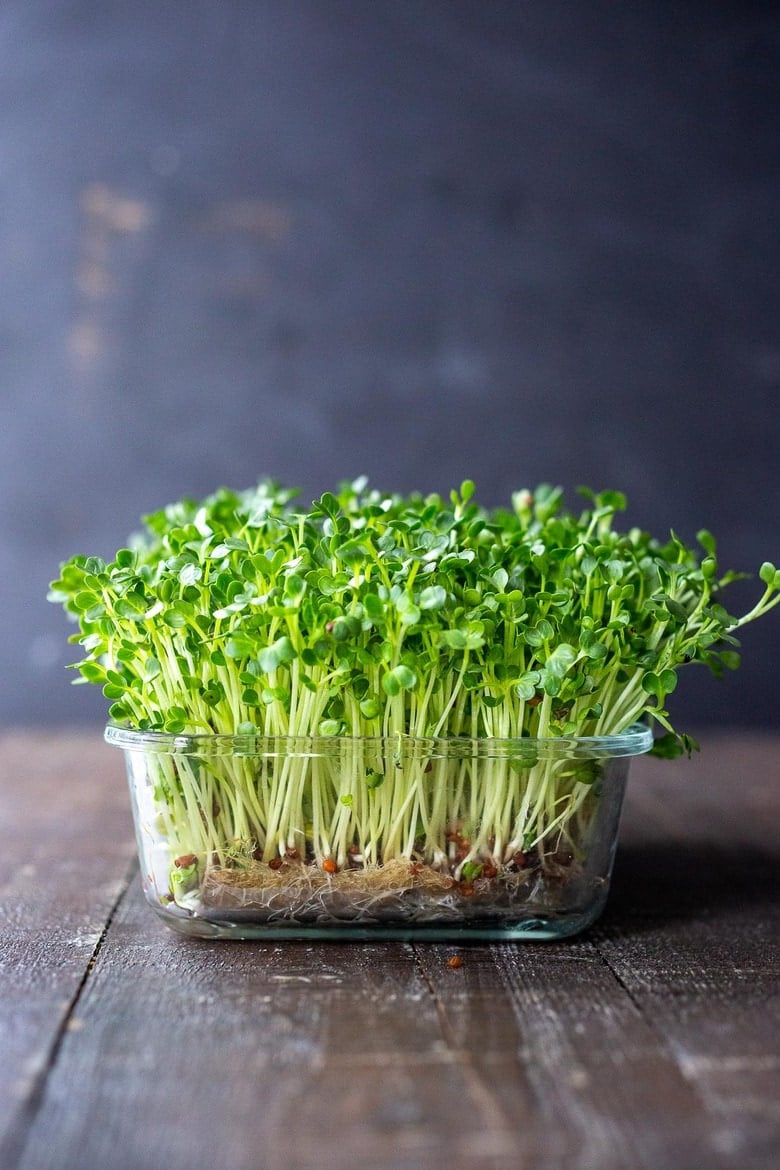
Your heart is full of fertile seeds, waiting to sprout. ~Morihei Ueshiba
It is hard not to smile when you see your first batch of happy microgreens reach up to sun, especially in the midst of winter. We all crave sunlight; nothing is more magical than watching these little guys turn their faces to the sun. Such a simple thing, but it never fails to lift my spirits.
Microgreens are packed with tremendous nutrients- so much more than their full-grown counterparts. I once read somewhere that eating “living” foods adds years to our life while eating “dead” foods removes years from our life. Broccoli sprouts, in particular, have more sulforaphane than any other veggie.
I always think of this when eating them. They are about as living as you can get! Plus, they are just so cute. Right? They make everything better. Add them to things you already make – salads, wraps, sandwiches, buddha bowls. Top off your soups or entrees with them, and add to juices and smoothies. Not only are they highly nutritious- they are very flavorful!
10 Health Benefits of Microgreens (Broccoli Sprouts)
- Cancer-Fighting Many microgreens, especially broccoli, contain high levels of sulforaphane, which research shows inhibits the growth of cancer cells.
- Prevents chronic disease. Microgreens have many health-promoting micronutrients to help stave off major diseases.
- High in Minerals. Microgreens have larger quantities of minerals than their vegetable counterpart.
- High in Antioxidants.
- May lower cholesterol
- 40 times more nutrients than their mature plant counterpart.
- Helps with weight management
- Microgreens are considered a prebiotic which feeds good bacteria in the gut.
- Possibly lowers blood pressure
- High in Vitamins A, Beta Carotene, C, E, K and Lutein.
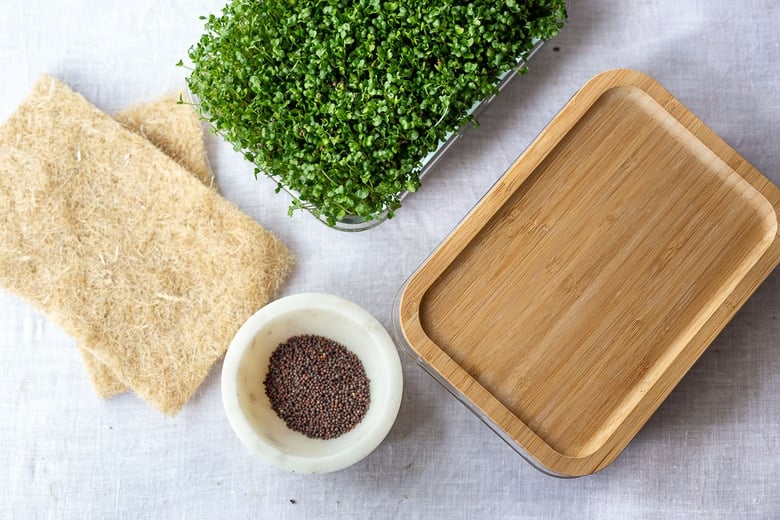
What you need to grow Microgreens at home:
- Glass or ceramic container with a lid
- grow mat or pad (hemp, coconut, jute or natural fiber)
- sprouting seeds (see list below)
- water
- a window
***Here is a handy Microgreens Kit we sell at our Shop!
Do you need lots of light to grow Microgreens?
No. Microgreens can grow indoors in the dead of winter, even in low light conditions, if placed near a window. Colder climates require a longer growing period (2 weeks) where warmer climates can produce microgreens in 5-7 days.
What is the difference between Microgreens and Sprouts?
In essence, sprouts and microgreens are the same seed, but at different stages of development. Microgreens are “mature” sprouts, which have been allowed to grow a little longer to the stage where they have visible leaves. Because of their tiny leaves, microgreens have much more flavor and possibly more nutrients than baby sprouts. Because you can keep them alive up until you cut them, they last much longer than sprouts.
Sprouts can grow in a jar with just water, where microgreens need a base- either a growing pad or soil.
Both microgreens and sprouts can be grown indoors.
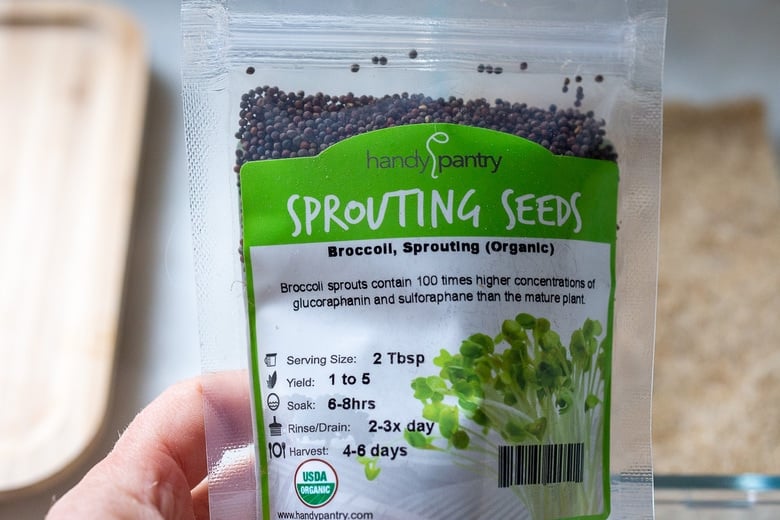
What are the healthiest Microgreens?
Broccoli sprouts are one of the most nutrient-dense microgreens you can grow. They are full of glucoraphanin and sulforaphane which are known to prevent cancer. They are highest in minerals and vitamins, so I usually grow these along with another flavor.
Microgreen Seeds (that can grow on a mat)
- Broccoli seeds
- kale seeds
- peas
- arugula
- radish or spicy radish
- amaranth
- chia
- mustard
- beet
- buckwheat
- chard
- cabbage
- cilantro
- fenugreek
- basil – opal basil is pretty
*Sunflower sprouts require soil for germination.
How to grow microgreens (in a nutshell)
- Soak the seeds 6-8 hours, or according to package directions.
- Soak the growing mat with water, and place in a container or baking dish.
- Spread out the seeds.
- Cover tightly and place near a window until the seeds sprout 2-3 days.
- Remove lid, and let grow until vibrant leaves appear.
- Water daily.
How to Grow Broccoli Sprouts (Step-by-Step)
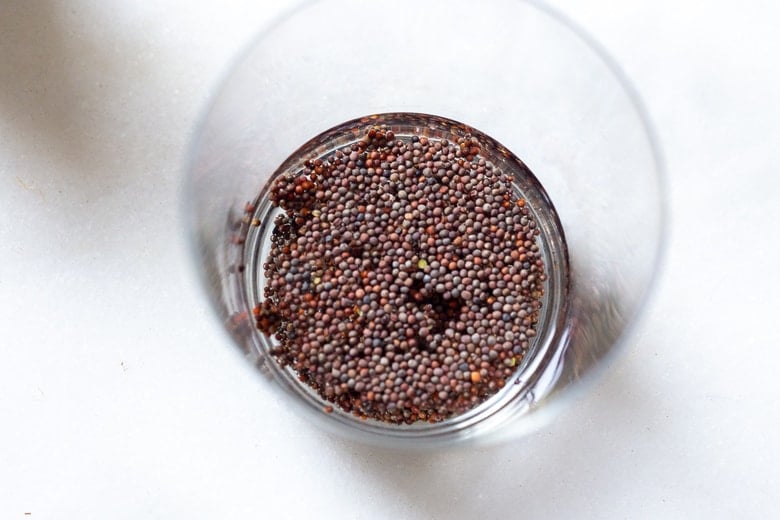
Step 1. Soak the seeds, according to package directions, then drain the seeds.
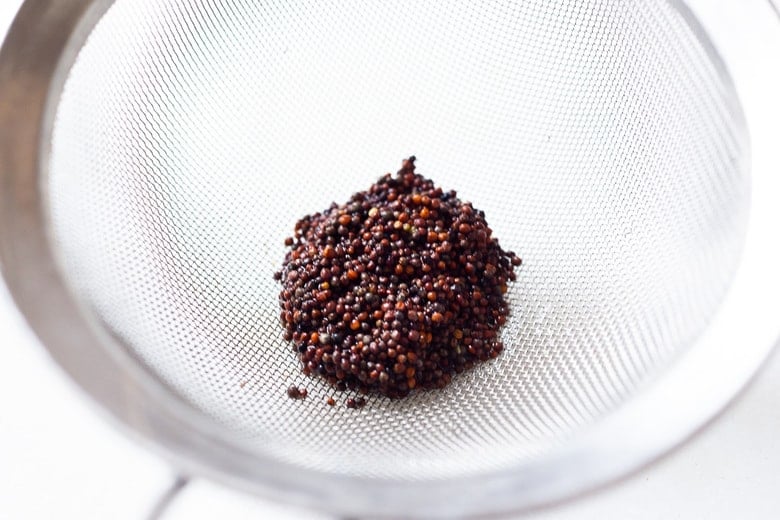
Step 2: Here I’m using a 5″ x 7″ inch glass container with a lid. Prepare a growing mat.
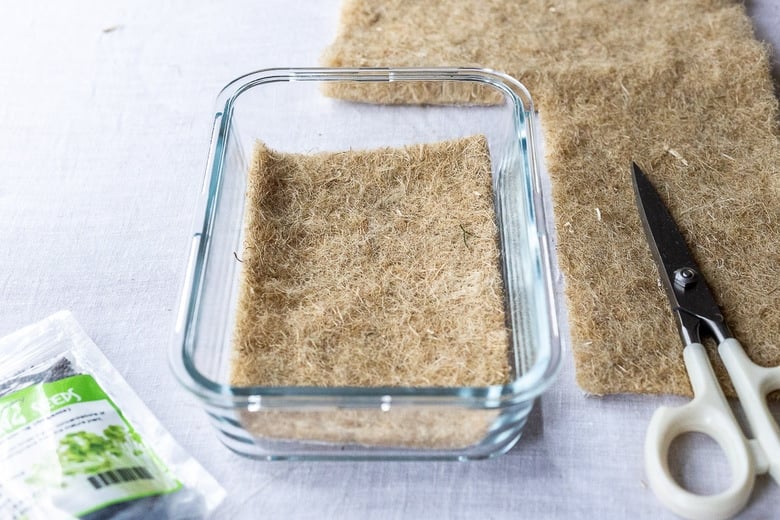
Soak the growing mat well. Here I’m using a natural jute mat. You can find these on Amazon or here at our shop.
You’ll need a new mat for each batch you grow, because the roots tend to really hold on, but they are relatively inexpensive.
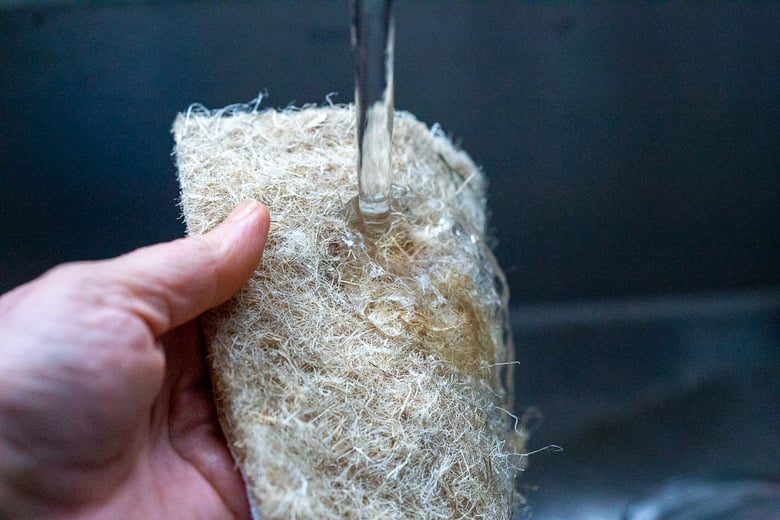
Place the drenched growing mat in the container.
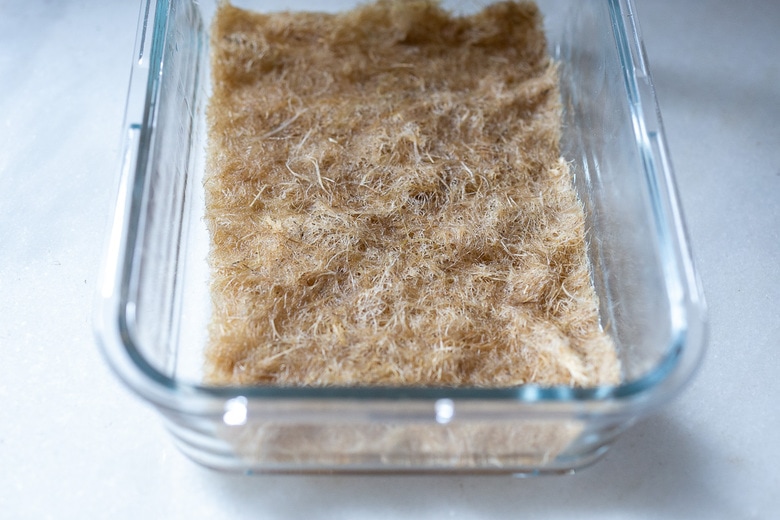
Step 3: Spread out the seeds as evenly as possible. I use 2 tablespoons seeds for a 5×7 inch area. If your seeds seem dry, spray with water. You don’t want them standing in water, just very wet.
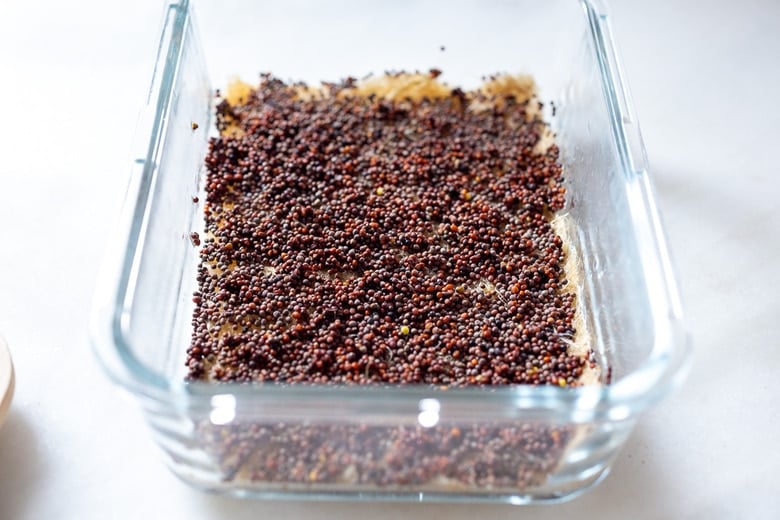
Step 4: Cover and place by a window until they sprout. This may take up to 5 days in cold climates or 1-2 days in warm climates. Soaking them does help them sprout faster.
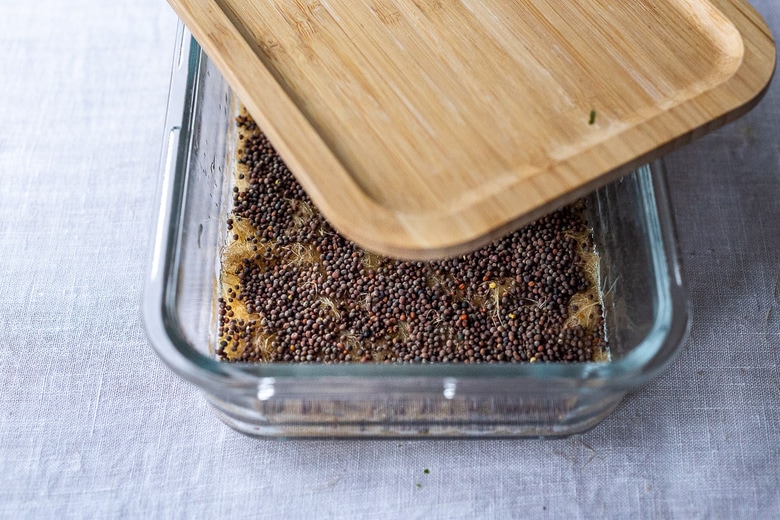
This was after day 2. A couple of little sprouts.
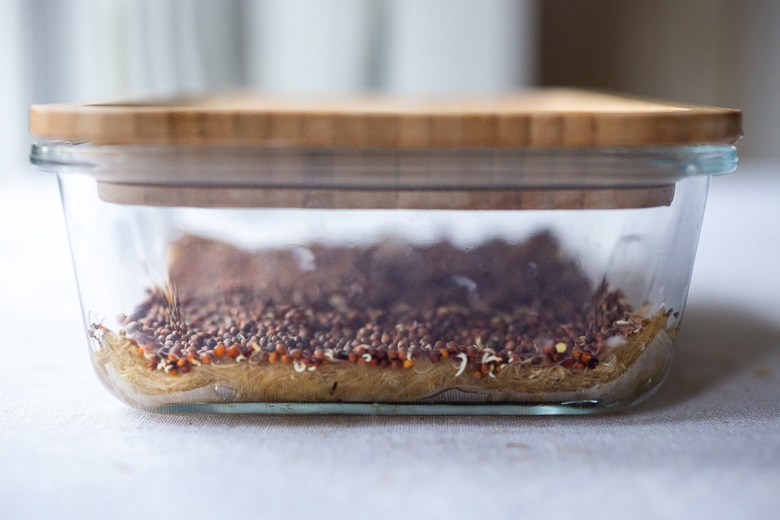
This was after day 5.
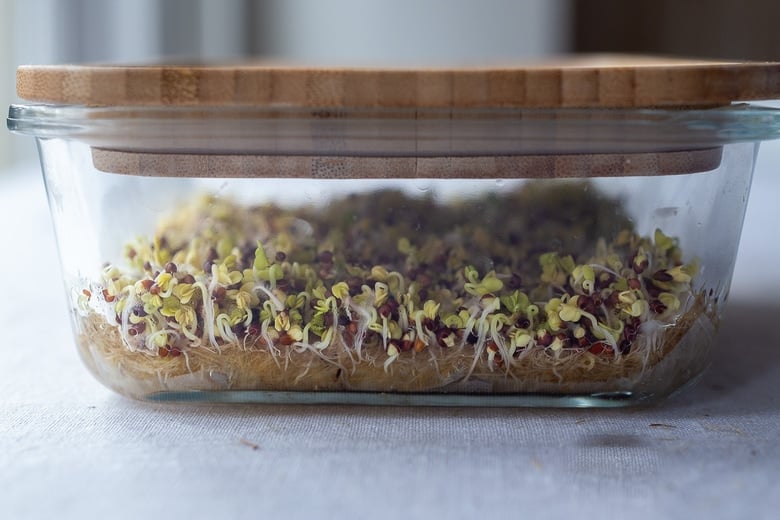
When most of the seeds look sprouted, remove the lid. Water daily so the growing mat stays nice and moist.
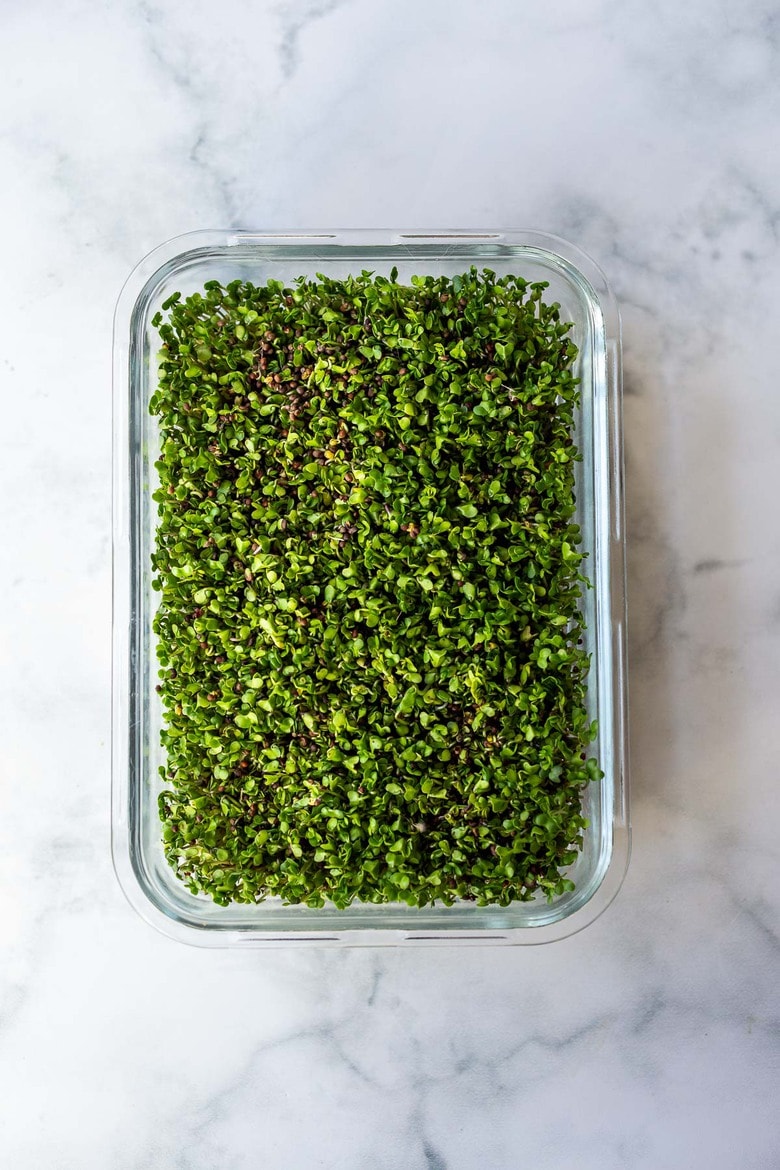
This photo above is day 10.
Step 5: Continue watering daily. After the sprouts take root, you can water generously and then pour out the extra water, the sprouts will adhere to the mat.
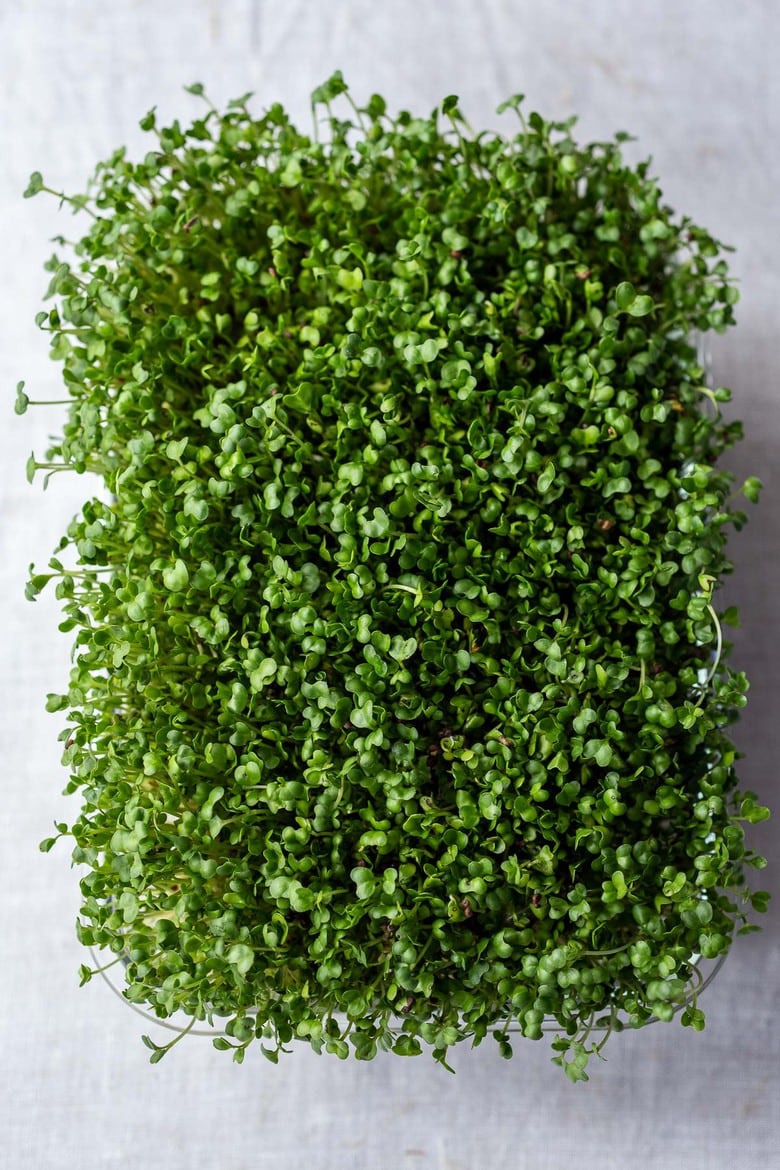
This is day 14. Wait to use the microgreens until they peek over the container by at least an inch.
Cut what you need for that meal, letting the rest continue growing. I like to have two batches growing…
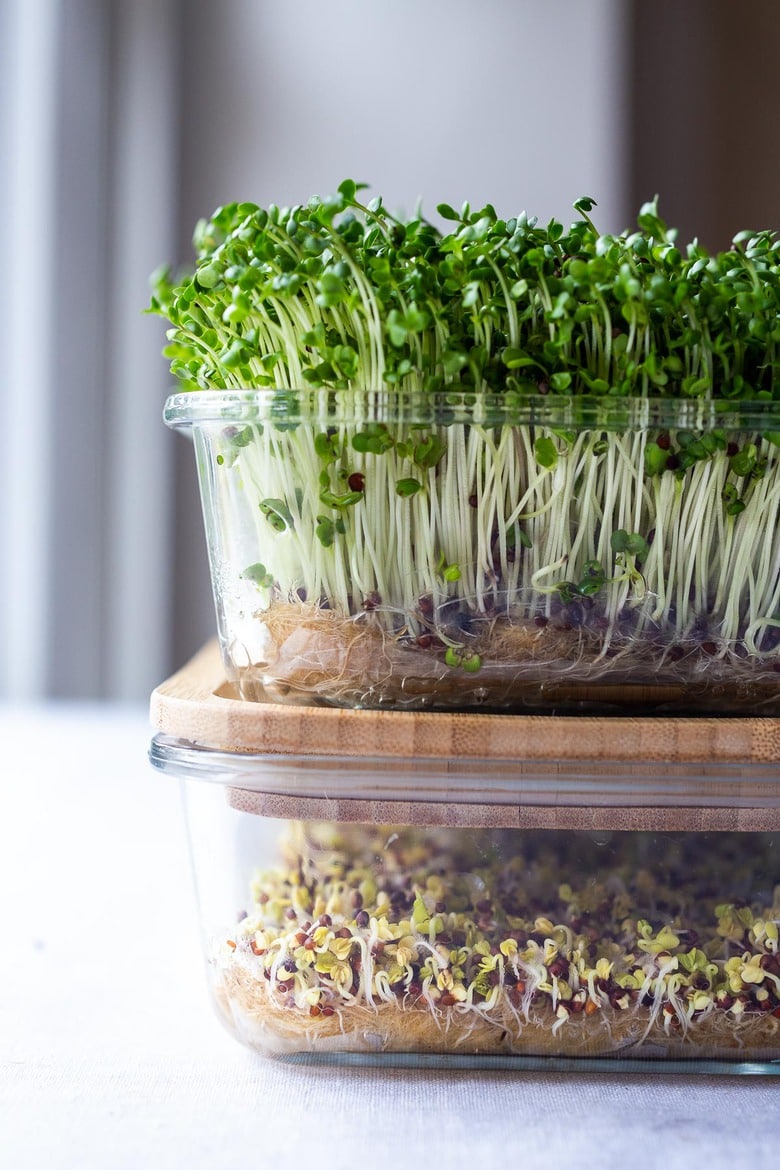
Ways to use Microgreens
- Curried Cauliflower Soup
- Spicy Mexican Oaxacan Bowl
- Creamy Vegan Broccoli Salad
- falafel bowls
- 20 Buddha Bowls (Vegan & Plant-Based!)
- Carrot Salad with Quinoa and Almonds
Growing microgreens is truly very simple and easy! Such a joyful thing to do in winter when we all could use a little pick-me-up. Here is our Microgreens Kit we sell at our Shop!
Give them a try and enjoy all the flavor and health benefits they bring.
xoxo
How to grow microgreens | Video
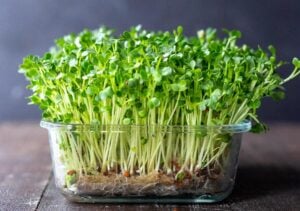
How to Grow Microgreens
- Prep Time: 15 mins
- Cook Time: 14 days
- Total Time: 14 days
- Yield: 5"x7" flat container. 1x
- Category: how to, projects, diy,
- Method: grow,
- Cuisine: vegan
- Diet: Vegan
Description
How to grow microgreens indoors in 1-2 weeks, using no special equipment. Enjoy the tremendous health benefits of consuming microgreens daily- adding to meals you are already making. Plus 10 Health Benefits.
Ingredients
- 2 tablespoons sprouting seeds- broccoli seeds, radish, kale, chard, arugula, cilantro, chia, buckwheat, etc.
- 5” x 7″ inch container with lid (or use plastic wrap or beeswax wrap)
- 5″ x 7″ inch growing mat
- water
- window
( Here is a handy Microgreens Kit we sell at our Shop! )
Instructions
Soak seeds according to directions on the package (6-8 hours). This will hasten sprouting time. Drain. (Alternatively, if you choose, you can skip soaking and spray the seeds with water using a spray bottle, once they are on the mat. This is what I typically do.)
Soak the growing mat (you want this quite wet) and place it in the container.
Spread out the seeds as evenly as possible- sometimes giving the container a little shake will help.
Cover tightly and place near a window. If you don’t have a lid, use plastic wrap or bees wrap, to keep the moisture in. (If it is freezing outside, place it a foot away or so). Inspect daily.
When most of the seeds have sprouted- this may take up to 5 days-remove the lid. (You may notice some white webbing- this is OK). Keep by the window and water daily. As the sprouts get rooted in the mat, you could drench the pad with water, then pour off the extra water.
Let the sprouts grown into tall microgreens, with little leaves, 7-10 more days, watering daily.
To use, cut off what you need at the base, with scissors, leaving the rest to grow. Sprouts keep best if they are growing! If you absolutely must store them, place them in a sealed zip lock back with damp paper towels in the fridge. They will keep 5-7 days.
Notes
Refer to the package for soaking instructions as each seed is different.
Nutrition
- Serving Size: ½ cup
- Calories: 10
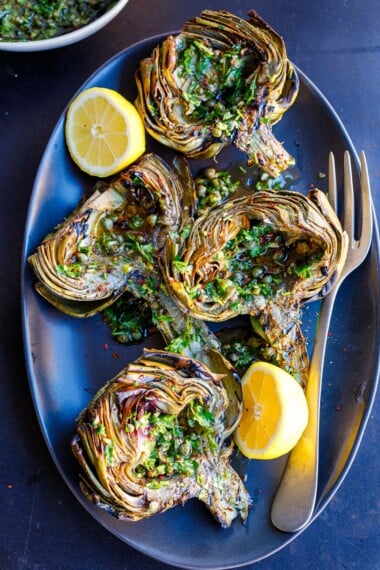
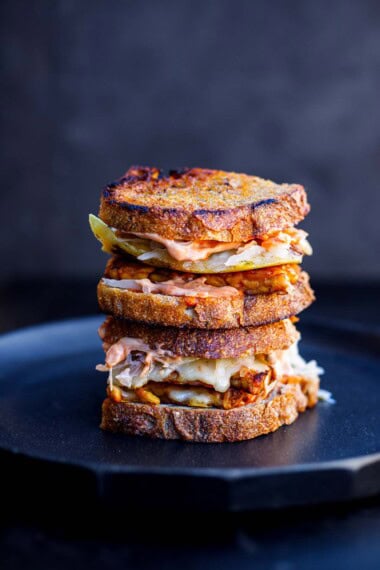
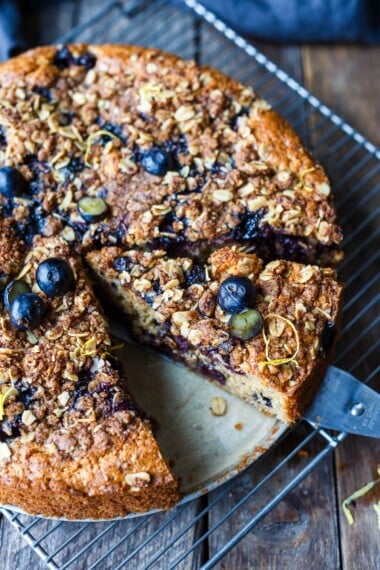


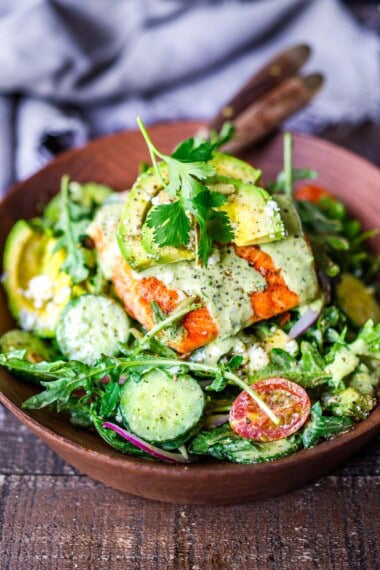

Which microgreens need to be grown in soil?
Sunflower Seeds!
Thanks! 🙂
Where is the video???
Hi Nia- try turning your adblocker off. Or try a different browser?
Hello, what do you do with growing mats after harvesting the microgreens?
they are compostable!
All goes well until bam, mine just keel over and get stinky. I’m wondering if the spot I place them to sprout gets too much sun? Where do you keep yours?
In an eastern-facing window, with morning light.
I had a problem with mold on one end of the dish. This was after about a week of growing; the sprouts were almost one inch above the dish and I noticed an area at one end that had sunken in and looked moldy. What could I be doing wrong? I pulled out the molded bits and I still have about 4/5 of the tray that looks ok. I think I should be able to safely harvest what’s left?
Oh no! Perhaps too much watering? I would absolutely harvest whatever is not touching the mold.
good job, will you teach me please
I love my kit purchased from your shop! My first batch has been amazing. Just curious how long you’d say each batch (mat) lasts. I think this one is about 3 weeks old and seems like maybe it’s done? How long before you compost usually?
That is about how long mine lasted. About 3 weeks.
Does the cover need to be tight fitting or can you lay a dish towel over the tray?
You want to keep the moisture in, so tight fitting. If you don’t have a lid, maybe plastic wrap or beeswax wrap with a book on top.
My seeds sprouted on day 3. Today is day 5 and they have already taken root. I got my daughters started on this fun project as well and we now exchange picture updates on our little guys’ progress. Thank you for this post and for getting us started on growing microgreens.
Awesome- it is so much fun!
This was inspirational. Thanks. I now have 4 nice little containers growing.I’ve already nibbled a few cotyledons and they are so good. Mine sprouted in one day in a cold room and in just a few days have progressed to the photo you show at day 10! I experimented with soaking and not soaking the seeds. I sprayed the not-soaked seeds all day the first two days (pandemic lifestyle) and they are outpacing the soaked seeds by a little bit.
I prefer not soaking as well- easier to spread.
Hello, thanks for the post! I did it with cooking seeds (and not sprouting seeds), an I still eat the microgreens?
Fun! Yes, OK to eat. What kind of seeds did you use? I just started Fenugreek- love them!
Thank you! great info here.
Thank you! great info here
Hi there
Makes me wanna try this. Where is this glass container from?
Thanks so much!
I got mine at Ikea, and they have similar on Amazon. We also have a kit at our Bowl and Pitcher Store.
Hi Sylvia,
Can you grow these in plastic containers with sealable lids, as in supermarket containers that you usually get with food in?
Yes, I don’t see why not.
Hi! I am new to sprouting. Once the greens are done growing, do you through the mat out and start a new one? Or can you keep using the same mat?
You’ll need a new one. 😉
Can you reuse the growing mat for the micrometers? Is it difficult to disengage the small “roots” from the mat?
I don’t reuse the mat.
This looks really fun to try-especially in the winter! Can you reuse the growing pad or is it one use only?
Best to use a new one.
can you reuse the mat after they’ve finished growing? Or do you need to replace the mat?
Love this idea.
I use a new one each time.
I love this idea! I’ve made sprouts many times before, but never microgreens. I’m guessing the jute mats can’t be re-used and that you have to throw them out after each batch (or compost them?) Is that right?
Compost yes.
Please tell me if you can reuse the jute liner to grow more seeds. How many times can you reuse them? Thank you.Glo
Hi, I don’t reuse the liners. They are relatively inexpensive.
What perfect timing! I have a pack of microgreen seeds waiting to plant. Wondering if a sponge topped with walnut pad (product says ground walnut shells with recycled fibers) would work for a trial batch?
Is the coconut pad like the liners used for hanging baskets?
Thank you for any advice!
I guess I used a Jute pad. Sorry I thought it was coconut, but it is jute. I linked in the post.
Make sure you know if your sponge has weird stuff in it that you wouldn’t want as a growing medium.
Great article….love your site.
Where did you purchase the coconut mat?
We will be offereing at our store- I will post wome links soon!
Thank you for posting this! The hubby and I were just discussing growing microgreens since every time I buy them, they go bad before I can use them, most recently within 2 days of purchase. So frustrating! I’m curious as to where you source them from Sylvia. Would it be possible for you to add a link to the Handy Pantry seeds that you have shown in the photo, or to any other place you get them from? Thanks so much!!
Yes, I will add some links. 🙂
I concurr-and will try a few more types! All winter I keep a tray of pea shoots on my kitchen table…they are beautiful and the family graze on them (want kids to eat salad? Let them pick their own). I make salad with them, toss onto a pasta dish (pea and mushroom, carbonara, blue cheese, salmon and cream etc) or use to garnish a roast squash risotto, soups etc. Radish are another favorite–esp the lovely pink stemmed ones, and these are standard garnish for your pupusas, tacos, etc. Corn shoots were supersweet, but to me tasted like aspartame (blech). As to sunflowers, I use black seeds and sprout them directly in a pierced sprouter tray (soak the seeds a few hours first) without soil, and they work fine (I get good qualit non-GMO seeds on-line from Mumm’s Sprouting seeds). Sunflower make a nice hefty sprout great in salads.
Thanks Bri! Will have to try the Sunflower sprouts- thanks for the tip!